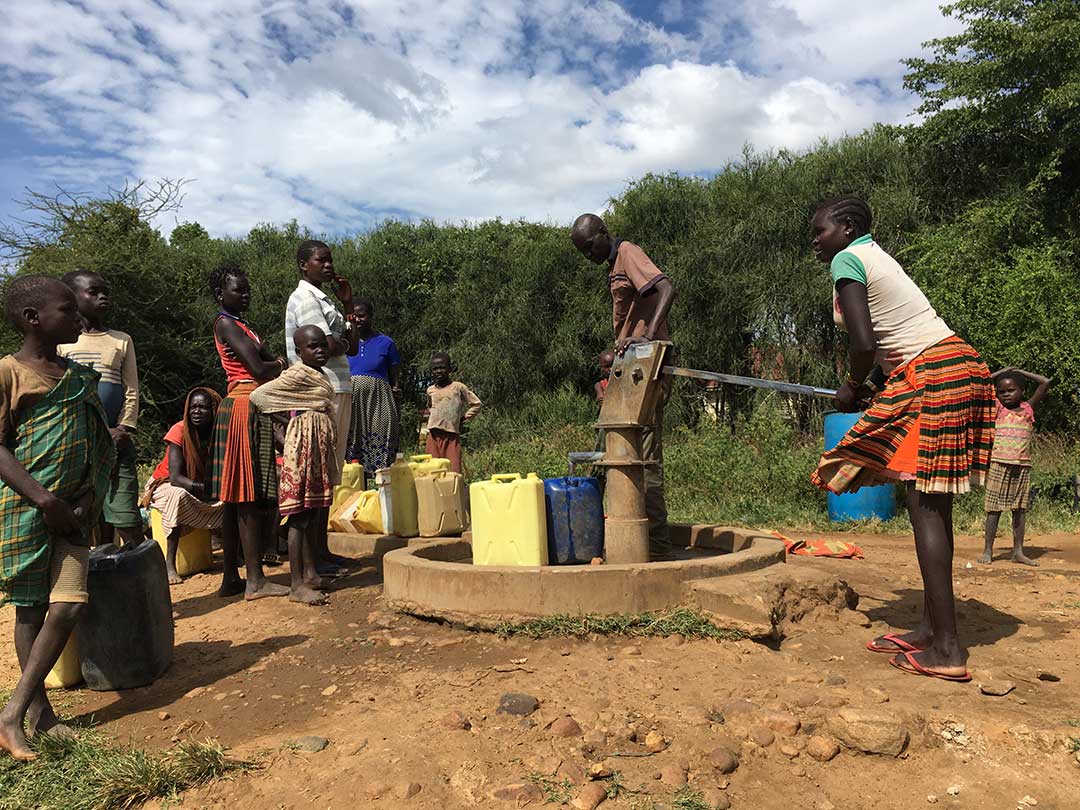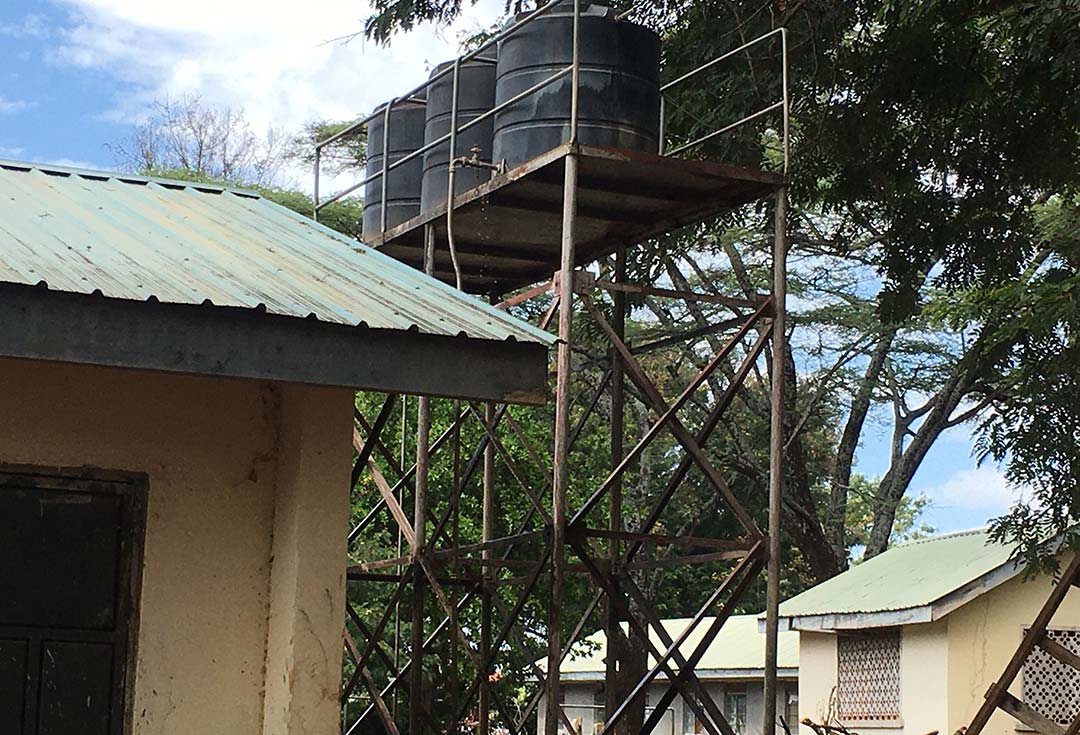Solar-powered water pumps reduce hospital visits in semi-arid northern Uganda
In Nabilatuk district, Karamoja, piped water has arrived as a boon to human health. But amid climate change, experts fear clean drinking water promises to become an even more stressed resource.
- 2 May 2024
- 6 min read
- by Pius Sawa

For many years, Teresa Longole woke up at five in the morning and walked ten kilometres to fetch water from a river. The river was seasonal, and shared by both humans and animals. Her children returned from school in the evening to walk the same distance to fetch water when the cows had moved on.
The water was not safe for human health. “You have to wake up ahead of the cows so that you can get some fresh water, but once the cows reach there, they step in the water, urinating and even pooping in it,” said Longole. A thirsty child or woman would drink the dirty water right from the dam, without boiling it first.
“Initially, diarrhoea diseases were number three in the district. As we talk now, they are outside the top five. They are number seven. Skin diseases used to be among the top ten, but have gone below the ten most causes of infections.”
– Dr Peter Lokwang, acting District Health Officer

Credit: Pius Sawa
Karamoja, in Uganda’s north, is a semi-arid pastoral region that sees scarce rainfall and long droughts. During the rainy season, the streams, earth dams, ponds and wells would fill up, “but when drought comes, you have to move a longer distance in order to get water from drying rivers,” Longole explained.
Families struggled with illness. There are no comprehensive records of the number of deaths due to waterborne diseases, but James Ocaa, an expert in water and hygiene in arid regions who has spent long years testing water samples in the Karamoja sub-region, said common diseases linked to contaminated water included typhoid fever, cholera, giardiasis, dysentery, E. Coli infections, hepatitis A and Salmonella infections. All these diseases precipitate diarrhoeal disease, with symptoms that can include fever, abdominal pain, blood in the stool and stomach upsets.
“One of the most [common] causes of mobility in the district has been the diarrhoea disease, especially during the rainy season,” said Eric Lolemu, a health educator from Nabilatuk, Longole’s home district. “Most villages lack pit latrines, and when combined with drinking untreated water and not practising hand-washing, waterborne diseases become a cause for increased movements to health facilities.”
A UNICEF report released in January 2024 shows that diarrhoea remains a leading killer of young children in the world, with Africa and Asia being hardest hit.
Solar water pumps
In 2020, during the COVID-19 pandemic, the government of Uganda together with international development partners rushed to the region to start setting up water systems to save lives. “We did not have these water systems in place. It was during COVID when we started having piped water,” said Paul Lokol, the chairperson of Nabilatuk district, which has a population of around 120,000. “Every village now has clean water,” Lokol adds.
Longole can now access clean water from a solar-powered pump just a few metres from her home, and she is a member of the solar water system management committee whose mandate is to watch against misuse and vandalism. Her children no longer have to spend their after-school hours fetching water from the river, and instead, have enough time to do school work. Hygiene in their home has improved, Longole said.
Dr Peter Lokwang, the acting District Health Officer, said the effects of the improved water system on health are evident. “Initially, diarrhoea diseases were number three in the district. As we talk now, they are outside the top five. They are number seven. Skin diseases used to be among the top ten, but have gone below the ten most causes of infections”.
Have you read?
With a renewed insistence on the importance of hand-washing, school children are off sick less often, and able to stay in class, locals say. Health centres, too, have seen improvement in hygiene. Christine Onyang, the officer in charge at Natirae Health Center said mothers who came to give birth at the centre were sometimes unable to clean up properly after delivery, as there was no nearby water source for them.
“When a mother came to deliver at night, we could keep the clothes there till morning because of insecurity. Nobody could risk walking to the only borehole to fetch water at night. But now the solar water pump at the health centre has really helped us. Anytime, you can access clean water.”
The scale of disease at the health centre, she said, has reduced as a result of people accessing clean water. “Our people didn’t know that the water was dirty. They were using stagnant water, but since the solar water pumps came, the hygiene in homes has improved,” she adds.
Accessibility versus safety
But James Ocaa cautions that easy access to water should not be mistaken for water safety. Safe water chains must be understood, and communities must adhere to safe and clean water practices.
“Water can be contaminated from five points. From aquifers, as there is a possibility for surface water meeting with ground water. Water can also be contaminated during curing, transportation, storage and consumption. So, it is very impossible to say communities are taking clean water because they have solar pump wells.” He said access to water should work in hand with technology to make it safe.

Credit: Pius Sawa
Dropping of water levels
Meantime, amid climate change, the longer-term outlook for access to water is troubling. According to Lokol, it is now hard to drill shallow wells in the region. “Some years back, we could drill boreholes and get water a few metres underground, but it has become difficult as we now have to drill deep wells. The water table has moved, and this means we have to invest more in accessing the water.”
Lokol says Karamoja region is rich in minerals and oil, and therefore caution has to be taken not to get water that is adulterated. “The terminology ‘arid’ serves for dry areas or desert-like, and with common understanding, desert areas are considered areas with high mineral concentration, meaning even water within could be having some minerals that are harmful to humans – things like nitrate, arsenic, copper, magnesium and others which may be cancer-causing and other-disease related.“
He said water ought to go through regular quality analysis to be sure of its safety – but logistically, this is a difficult standard to meet. “During rainy season, an improved well is supposed to be tested for quality analysis after every three months, while in dry seasons, the testing should be every six months. This doesn’t give the laboratory any resting time.”
Meantime, however, villagers from Nabilatuk district are enjoying the convenience of having water pumped to their doorsteps. Paul Ngiro from Ajokolup village is a happy father of five, who says water in the community has made life easier for his family, as his wife and children no longer travel long distances to return with patently unclean water. “We thank the government and partners for installing this solar water pump here so that we can also live a better life,” he said.
“Once a community has clean water, it impacts on their health in terms of cutting transmission of water-borne diseases,” said Lolemu.
It doesn’t stop at gastric illnesses linked to the consumption of contaminated water. Trachoma, a sometimes-blinding eye-disease transmitted by flies, which more common in drier parts of the world, and which has been shown to be less prevalent when sanitation improves, is among the most common illnesses in the district, according to Lokwang. Hearteningly, the prevalence of the illness here has recently fallen in prevalence from 10.5% to 0.3%.
“WHO tells that for you to control trachoma, you must have a prevalence of less than 5%. In our last survey, in 1,000 people we interviewed, we only found about three, which is a very negligible population,” he said.





